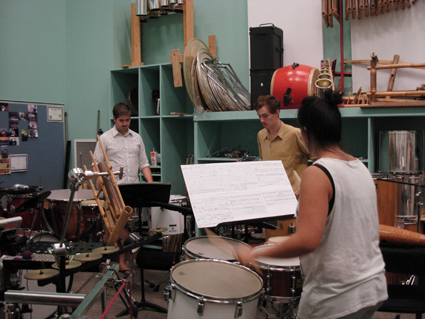percussion: the next generation
matthew lorenzon: nomad percussion, a national percussion project

Nomad Percussion
photo courtesy the artists
Nomad Percussion
THE PERCUSSION ENSEMBLE MOUNTED THE STAGE TO DEAFENING APPLAUSE. THEY HAD TRAVELLED THOUSANDS OF MILES ONLY A WEEK BEFORE TO FIERCELY REHEARSE THE MOST CHALLENGING CONTEMPORARY REPERTOIRE FROM AROUND AUSTRALIA AND THE WORLD. THEIR BACKS ACHED AND THEIR HANDS WERE RAW FROM THE ORGANISED MAYHEM THEY REFUSED TO BLUFF. THE HALL FELL INTO AWED SILENCE. THE ENSEMBLE PAUSED, BREATHING IN UNISON.
This was not exactly the concert I attended, but rather the impression I got watching the six interstate percussion students that comprise Nomad Percussion perform their debut concert at the ANU’s School of Music. The room was small, but the courageous atmosphere surrounding their performance of such large-scale works as Anthony Pateras’ Refractions and Iannis Xenakis’ Persephassa on a week’s rehearsal was unforgettable.
When the members of Nomad Percussion met at National Music Camp it became evident that they should share their expertise and networks by forming an interstate percussion ensemble. In doing so they would build on the strengths of an already active Australian percussion scene, crossing the largely geographical but to some extent taste-driven divide between the repertoires of Synergy Percussion in Sydney and Speak Percussion in Melbourne. The welcome diversity of works on their debut program attested to the success of this formula. Last Waltz by Synergy artistic director Timothy Constable presented that group’s driving tom toms, snare drums and bongos. This tour de force contrasted well with Melbourne-based composer Mark Pollard’s minimalist reverie for vibraphone, The Heavenly Muzak Machine, the third movement of which features an undulating hymn played only with the fingertips.
In terms of scale, the highlights of the performance were the sextets Refractions and Persephassa, both pieces performed by Speak Percussion at the 2011 MONA FOMA (RT 102, p5). Steve Fitzgerald conducted Pateras’ Refractions, drawing from his experience performing the piece with Speak the previous year. The opening sextuplets where six timbres are rapidly passed between the performers were tightly executed with the relatively dead performance space lending a precision to quiet sounds and those with a fast attack. As such, the standout moments of the performance were not those of dynamic climax but the combination of wood rattles with crumpled paper and wood claps with kick drums and cymbal rolls. The intimate space also lent drama to the ear-tickling tones produced by Anna Ng’s expertly rubbed shot glasses.
While the grand spatialisation of Xenakis’ Persephassa suffered from the nigh on claustrophobic conditions, the physical energy and command of conductor William Jackson transported the audience to a hall eight times the size. Here the ensemble exhibited its greatest sense of musical intention, sustaining a uniformity of dynamics and timbres in the sounds passed around the room while deftly managing global dynamic and rhythmic changes. This strength of vision never waivered as the lengthy piece drew on the performers’ energy reserves, nor when they were called upon to blow whistles while playing.
It is thrilling to see Australia’s tradition of percussion moving from generation X to Y, especially with Nomad Percussion’s interstate vision and experience. I would like to see more concerts with this level of daring. Where is the Australian New Music String Quartet? The Oceanic Wind Ensemble for the Performance of Contemporary Music? The Intercontinental Students’ Electroacoustic Orchestra?
Nomad Percussion, A National Percussion Project, debut concert, ANU School of Music, Canberra, Feb 18
See RealTime 107 (p42) for Greg Hooper’s review of the debut of another percussion ensemble, Early Warning System. Eds.
RealTime issue #108 April-May 2012 pg. 38






